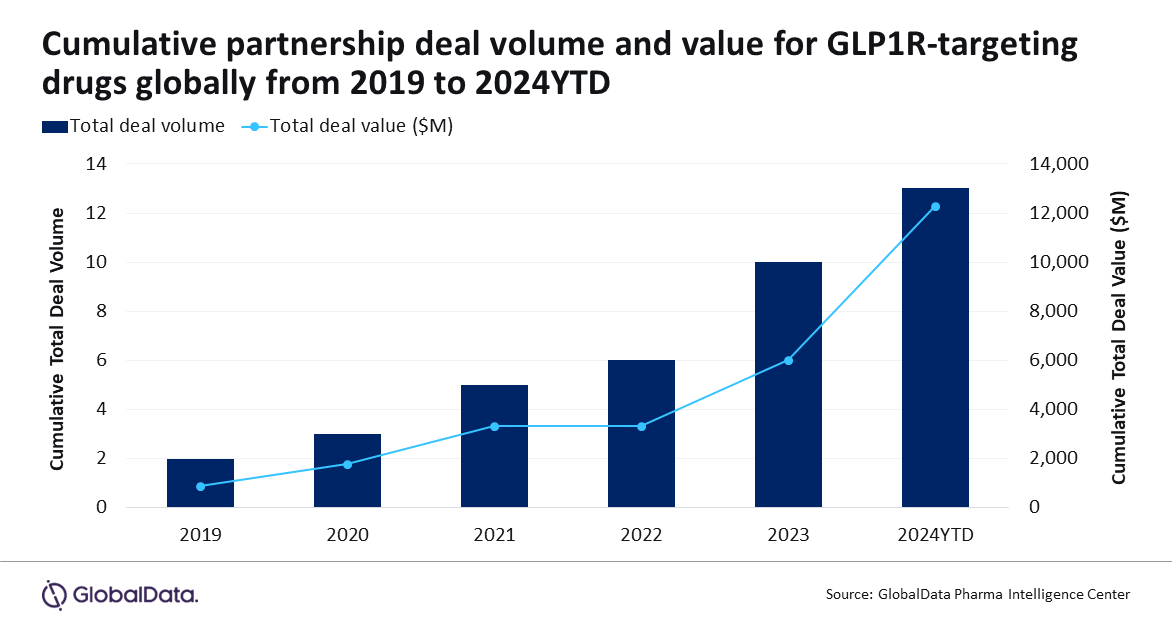NEW YORK — The recent success of obesity treatments, particularly Ozempic (semaglutide) and Mounjaro (tirzepatide), has driven significant interest in glucagon-like peptide-1 receptor (GLP1R) targeting drugs. These therapies have witnessed a 595% increase in licensing deal value between 2019 and 2024 year-to-date (YTD), exceeding $6.2 billion in 2024 YTD alone. Biopharmaceutical companies are now focusing on advancing these drugs to enhance efficacy and expand their therapeutic scope beyond type 2 diabetes and obesity, reveals GlobalData, a leading data and analytics company.
GLP1R agonists are currently used for the treatment of type 2 diabetes (T2D) and obesity. Over the past few years, Novo Nordisk’s GLP1R agonist Wegovy/Ozempic (semaglutide), and Eli Lilly’s dual GLP-1R/GIPR agonist Mounjaro/Zepbound (tirzepatide) dominated the market by achieving combined global drug sales of $47.6 billion in 2023, according to GlobalData’s Pharma Intelligence Center Drugs Database.
Alison Labya, Business Fundamentals Analyst at GlobalData, comments: “Biopharmaceutical companies are placing their bets on GLP1R agonists to challenge Novo Nordisk and Lilly, with currently over 120 GLPR1 drugs in clinical trials. Drugmakers aim to enhance efficacy, extend dosing intervals, target multiple indications other than T2D and obesity, and improve dosage via oral form.”
GLPR1 drug candidates currently in clinical trials include Pfizer’s Phase I once-daily oral GLPR1 agonist danuglipron, Amgen’s once-monthly injectable Phase II GLP1R/GIPR bispecific maridebart cafraglutide and Merck & Co’s injectable GLPR1/GCGR dual agonist efinopegdutide currently in Phase II trials for metabolic dysfunction-associated steatohepatitis (MASH).

According to GlobalData’s Pharma Intelligence Center Deals Database, licensing agreements for innovator drugs targeting GLP1R saw an increase in total deal value of $12.2 billion between 2019 and 2024 YTD, with two-thirds involved in Phase I to III clinical trials and a third in early-stage preclinical and discovery.
Labya adds: “Metabolic disorders was the top therapy area for licensing agreements involving GLPR1-targeting drugs, with a total deal value of $10.5 billion between 2019 and 2024 YTD. This was followed by cardiovascular with $6 billion in total licensing agreement deal value and gastrointestinal with $4.5 billion, demonstrating the expansion of the GLP1R drug class for indications beyond T2D and obesity.”
Of note, the period from 2022 to 2024 YTD witnessed a resurgence in licensing agreement activity for GLP1R-targeting drugs, totalling over $6 billion, where 2024 YTD has already achieved the highest total deal value in a year.
In May 2024, Chinese pharmaceutical giant Jiangsu Hengrui Medicine Co. out-licensed ex-China rights for its GLPR1 drug portfolio, including HRS-9531 – a GLRP1/GIP dual agonist in Phase III and II trials for obesity, T2D, and diastolic heart failure – to newly established US-based biotech Hercules CM NewCo in a deal worth up to $6 billion.
Earlier, in November 2023, China-based biotech Eccogene signed a $2 billion licensing agreement with AstraZeneca, granting ex-China rights to ECC-5004 – an oral GLPR1 agonist in Phase I trials for obesity and T2D and in preclinical testing for MASH, with plans for joint development and commercialization in China.
Labya concludes: “In light of the market leaders Ozempic and Mounjaro, there has been a recent increase in licensing deals for GLP1R-targeting drugs, especially billion-dollar agreements. This trend is likely to boost innovation, particularly in developing dual or tri-agonists that target additional disease pathways alongside GLP1R for greater efficacy. With several GLP1Rs currently in clinical trials, the priority for success will include being the first to bring an oral GLPR1 agonist to market and to exceed the safety and efficacy benchmark established by Novo Nordisk and Eli Lilly.”







